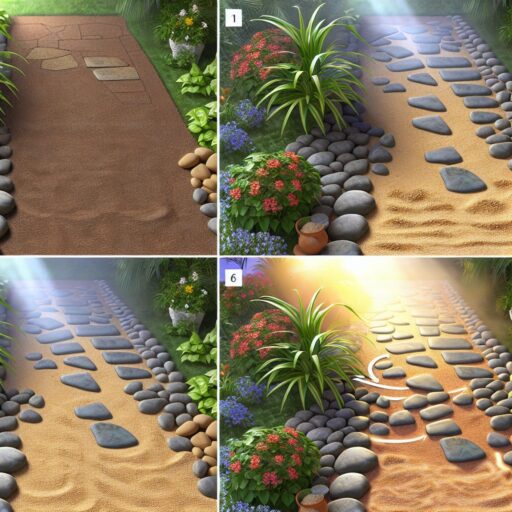Step-by-Step Guide to Creating Stunning DIY Walkways
Creating a walkway in your yard can be fun and useful. It makes your home look better and gives you an easy path to walk on. The best part is, you can do it yourself! This means you save money while adding charm to your outdoor space. With some simple steps, you can build a stunning DIY walkway. This is also a great example of affordable home improvements that anyone can try. Let’s learn how to do it step by step.

Choosing the Right Spot for Your Walkway


The first step to building a walkway is picking the right spot. Think about where people walk most in your yard. Does the area connect your driveway to the front door? Maybe it leads to a garden or backyard patio. Choose a place that will be used often.
Check the ground in your chosen area. Is it flat, or does it slope? Flat ground is easier to work with, but slopes can work too with extra planning. Look for any obstacles like tree roots or rocks. You might need to move or work around them.
Measure the length and width of your walkway. Use a tape measure to get the exact size. Draw the shape you want with chalk or spray paint. A straight path is simple, but curves can add flair. Make sure the walkway fits well with your yard’s layout.
Think about safety. The path should not be too steep or slippery. If water flows through the area when it rains, plan for good drainage. This keeps your walkway safe and long-lasting.
Lastly, check with local rules. Some areas have guidelines for outdoor projects. This helps you avoid fines or problems later. Once everything is checked, you’re ready to move forward!
Picking the Best Materials for Your Walkway

Materials play a big role in how your walkway looks and lasts. There are many options to choose from. Some popular ones include bricks, stones, gravel, and concrete pavers. Each has its own style and benefits.
Bricks give a classic and timeless look. They are durable and easy to arrange in patterns. Stones, like flagstone or slate, create a natural feel. They come in various shapes and colors. We have a blog post on how to lay a slate walkway. Gravel is affordable and quick to install. It’s great for casual paths but may need occasional upkeep.
Concrete pavers are versatile and sturdy. They come in many designs. You can mix and match colors to make unique patterns. Recycled materials like old wood or broken tiles are eco-friendly choices. These add character to your walkway.
Consider the weather in your area. For example, stones can get slippery in the rain. Gravel might shift after heavy use. Pick something that works best for your climate and needs.
Don’t forget about cost. Some materials are more expensive than others. Plan your budget carefully. You can even combine two materials to save money and add variety.
Once you’ve chosen the material, buy a little extra. This covers mistakes or future repairs. Now, you’re ready to gather your tools and start building!
Gathering Tools and Supplies

Before starting, collect all the tools and supplies you’ll need. Having everything ready saves time and effort. Here’s a list of basics you might require:
- Tape measure
- Shovel and rake
- Wheelbarrow
- Level tool
- Rubber mallet
- Landscaping fabric
- Gravel or sand
- Your chosen walkway materials (bricks, stones, etc.)
Safety gear is important too. Wear gloves to protect your hands. Use safety glasses if you’ll be cutting materials. Comfortable shoes with good grip are a must.
If you don’t own some tools, you can rent them. Many hardware stores offer rentals at low costs. This is a smart way to save money.
Double-check your supplies before you start. Running out of materials halfway can delay your project. Keep everything nearby so you don’t waste time looking for things.
With your tools and supplies in place, you’re ready to prepare the ground. Let’s move to the next step!
Preparing the Ground for Your DIY Walkway

Preparing the ground is key to making your walkway strong and smooth. Start by clearing the area. Remove grass, weeds, and rocks using a shovel or rake. This creates a clean surface to work on.
Dig about 4-6 inches deep along the marked path. This depth allows space for the base layers and materials. Use a wheelbarrow to carry away the dirt. Ensure the dug-out area is even. Check this using a level tool.
Lay down landscaping fabric. This stops weeds from growing through your walkway. Cut the fabric to fit the path’s shape. Overlap the edges slightly to cover the entire area.
Add a layer of gravel or sand on top of the fabric. Spread it evenly using a rake. This forms a stable base for your walkway materials. Compact the base using a tamper tool or your feet. A firm base prevents shifting over time.
If your walkway is on a slope, consider adding edging. This keeps the materials in place. Wooden planks or metal strips work well as edges. Secure them firmly into the ground.
Now your ground is ready for the next step—placing the walkway materials. Let’s see how to do this properly!
Laying Down the Walkway Materials

This step brings your walkway to life. Start placing the materials one by one. If you’re using bricks or pavers, lay them closely together. For stones, leave small gaps for a natural look.
Use a rubber mallet to tap each piece into place. This ensures they sit firmly on the base. Check the level frequently. Adjust materials as needed to keep the surface even.
If you’re using gravel, pour it over the base. Spread it evenly with a rake. Add more gravel until it reaches the desired height. Smooth the surface to remove bumps.
For curved paths, cut materials to fit the shape. Use a saw or chisel for precise cuts. Be careful and wear safety gear during this process.
Fill gaps between materials with sand or smaller stones. This locks everything in place. Sweep the surface to fill cracks completely. Add more filler if needed.
Step back and admire your work! Make any final adjustments before moving on to the finishing touches.
Adding Finishing Touches to Your Walkway

Finishing touches make your walkway stand out. Clean the surface to remove dust and debris. Use a broom or hose for this step. A clean walkway looks more polished.
Install decorative edges if you haven’t already. These can be made of wood, metal, or stone. Edges frame your walkway and prevent materials from spilling out.
Consider adding lighting. Solar lights are easy to install and eco-friendly. Place them along the edges for a warm glow at night. Lights also make the walkway safer to use.
Plant flowers or shrubs along the sides. This adds color and life to your path. Choose plants that match your yard’s theme. Mulch around the plants to keep the soil moist.
If you want extra durability, seal the surface. Use a sealant suitable for your material. This protects against weather and stains. Follow the product instructions carefully.
Now your DIY walkway is complete! It’s a beautiful and functional addition to your yard.
Maintaining Your Walkway Over Time

Maintenance keeps your walkway looking great. Regular care prevents damage and extends its life. Sweep the surface weekly to remove dirt and leaves. A clean walkway stays attractive.
Inspect the edges for wear and tear. Fix loose pieces immediately. This stops bigger problems from forming. Replace broken materials as needed.
If weeds appear, pull them out quickly. Spray weed killer if necessary. Keep the surrounding area trimmed and neat.
After heavy rain, check for water pooling. Improve drainage if needed. This prevents erosion and slippery spots.
Reapply filler to gaps every year. Over time, sand or gravel may settle. Adding more keeps the walkway stable.
By following these tips, your walkway will stay stunning for years to come!
Benefits of Building a DIY Walkway

There are many benefits to creating your own walkway. First, it saves money. Hiring professionals can be costly. DIY lets you control the budget.
It’s also a fun project. You learn new skills and get creative. Involving family members makes it even more enjoyable.
A walkway improves your home’s curb appeal. It makes your yard look organized and inviting. This can increase your property value too.
Walkways are practical. They provide a clear path for walking. No more muddy shoes or worn-out grass!
Lastly, it’s a form of affordable home improvement. You enhance your space without spending much. Plus, the pride of completing a project yourself is priceless.
Ready to start your own DIY walkway? Gather your tools and let your creativity shine!
Conclusion

Building a DIY walkway is easier than it seems. Start by choosing the right spot and materials. Prepare the ground carefully and lay the materials step by step. Add finishing touches to make it unique. Maintain your walkway regularly to keep it in great shape.
This project is a perfect example of affordable home improvements. It’s cost-effective, rewarding, and enhances your outdoor space. Whether you’re using bricks, stones, or gravel, your walkway will surely impress. So grab your tools and start creating today!
